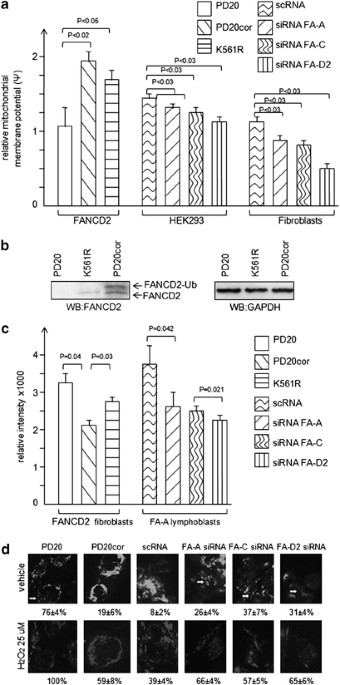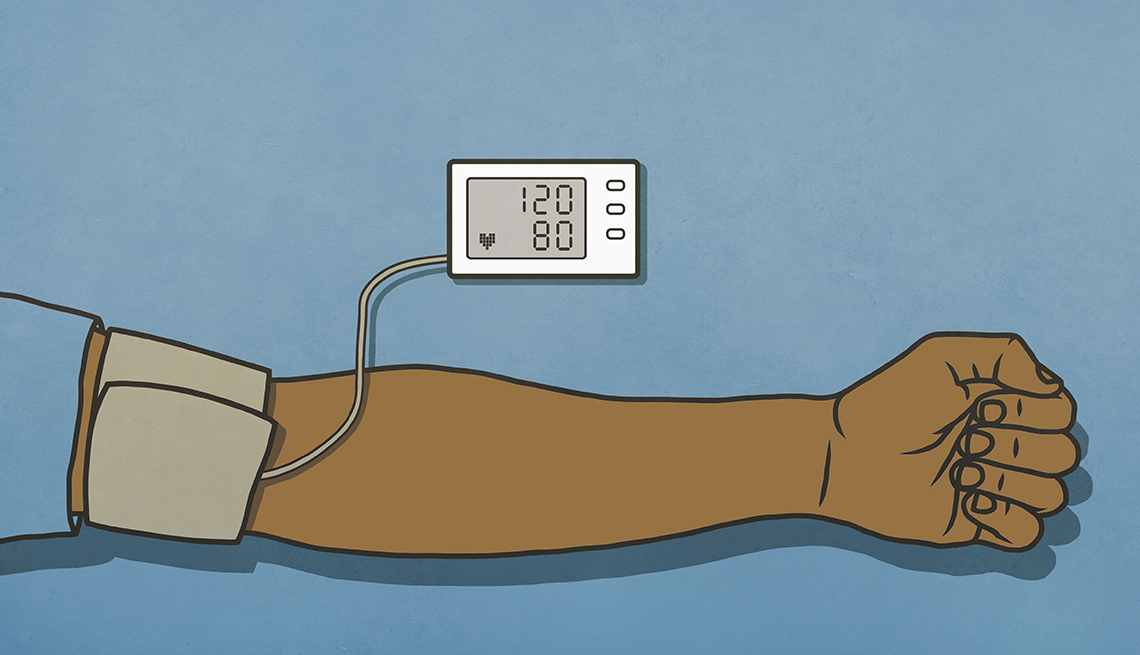
- Select a language for the TTS:
- UK English Female
- UK English Male
- US English Female
- US English Male
- Australian Female
- Australian Male
- Language selected: (auto detect) - EN
Play all audios:
ABSTRACT Fanconi Anemia (FA) is a rare genetic disorder associated with a bone-marrow failure, cancer predisposition and hypersensitivity to DNA crosslinking agents. Majority of the 15 FA
genes and encoded proteins characterized so far are integrated into DNA repair pathways, however, other important functions cannot be excluded. FA cells are sensitive to oxidants, and
accumulation of oxidized proteins has been characterized for several FA subgroups. Clinical phenotypes of both FA and other closely related diseases suggest altered functions of
mitochondria, organelles responsible for cellular energetic metabolism, and also serving as an important producer and the most susceptible target from reactive oxidative species (ROS). In
this study, we have shown that elevated level of mitochondrial ROS in FA cells is in parallel with the decrease of mitochondrial membrane potential, the decrease of ATP production, impaired
oxygen uptake and pathological changes in the morphology of mitochondria. This is accompanied by inactivation of enzymes that are essential for the energy production (F1F0ATPase and
cytochrome C oxidase) and detoxification of ROS (superoxide dismutase, SOD1). In turn, overexpression of SOD1 could rescue oxygen consumption rate in FA-deficient cells. Importantly, the
depletion of mitochondria improved survival rate of mitomycin C treated FA cells suggesting that hypersensitivity of FA cells to chemotherapeutic drugs could be in part due to the
mitochondria-mediated oxidative stress. On the basis of our results, we propose that deficiency in FA genes lead to disabling mitochondrial ROS-scavenging machinery further affecting
mitochondrial functions and suppressing cell respiration. Access through your institution Buy or subscribe This is a preview of subscription content, access via your institution ACCESS
OPTIONS Access through your institution Subscribe to this journal Receive 50 print issues and online access $259.00 per year only $5.18 per issue Learn more Buy this article * Purchase on
SpringerLink * Instant access to full article PDF Buy now Prices may be subject to local taxes which are calculated during checkout ADDITIONAL ACCESS OPTIONS: * Log in * Learn about
institutional subscriptions * Read our FAQs * Contact customer support SIMILAR CONTENT BEING VIEWED BY OTHERS CONGENITAL SIDEROBLASTIC ANEMIA MODEL DUE TO _ALAS2_ MUTATION IS SUSCEPTIBLE TO
FERROPTOSIS Article Open access 30 May 2022 DECIPHERING THE ROLE OF POST-TRANSLATIONAL MODIFICATIONS IN FANCONI ANEMIA PROTEINS AND THEIR INFLUENCE ON TUMORIGENESIS Article 15 June 2024
FERRITIN-MEDIATED MITOCHONDRIAL IRON HOMEOSTASIS IS ESSENTIAL FOR THE SURVIVAL OF HEMATOPOIETIC STEM CELLS AND LEUKEMIC STEM CELLS Article 24 February 2024 REFERENCES * Moldovan GL,
D'Andrea AD . FANCD2 hurdles the DNA interstrand crosslink. _Cell_ 2009; 139: 1222–1224. Article Google Scholar * Kim Y, Lach FP, Desetty R, Hanenberg H, Auerbach AD, Smogorzewska A .
Mutations of the SLX4 gene in Fanconi Anemia. _Nat Genet_ 2011; 43: 142–146. Article CAS Google Scholar * Vaz F, Hanenberg H, Schuster B, Barker K, Wiek C, Erven V _et al_. Mutation of
the RAD51C gene in a Fanconi Anemia-like disorder. _Nat Genet_ 2010; 42: 406–409. Article CAS Google Scholar * Vandenberg CJ, Gergely F, Ong CY, Pace P, Mallery DL, Hiom K _et al_.
BRCA1-independent ubiquitination of FANCD2. _Mol Cell_ 2003; 12: 247–254. Article CAS Google Scholar * Meetei AR, de Winter JP, Medhurst AL, Wallisch M, Waisfisz Q, van de Vrugt HJ _et
al_. A novel ubiquitin ligase is deficient in Fanconi anemia. _Nat Genet_ 2003; 35: 165–170. Article CAS Google Scholar * Kennedy RD, D'Andrea AD . The Fanconi Anemia/BRCA pathway:
new faces in the crowd. _Genes Dev_ 2005; 19: 2925–2940. Article CAS Google Scholar * Deans AJ, West SC . DNA interstrand crosslink repair and cancer. _Nat Rev Cancer_ 2011; 11: 467–480.
Article CAS Google Scholar * Ruppitsch W, Meisslitzer C, Weirich-Schwaiger H, Klocker H, Scheidereit C, Schweiger M _et al_. The role of oxygen metabolism for the pathological phenotype
of Fanconi Anemia. _Hum Genet_ 1997; 99: 710–719. Article CAS Google Scholar * Degan P, Bonassi S, De Caterina M, Korkina LG, Pinto L, Scopacasa F _et al_. _In vivo_ accumulation of
8-hydroxy-2'-deoxyguanosine in DNA correlates with release of reactive oxygen species in Fanconi's anaemia families. _Carcinogenesis_ 1995; 16: 735–741. Article CAS Google
Scholar * Bogliolo M, Borghini S, Abbondandolo A, Degan P . Alternative metabolic pathways for energy supply and resistance to apoptosis in Fanconi Anaemia. _Mutagenesis_ 2002; 17: 25–30.
Article CAS Google Scholar * Saadatzadeh MR, Bijangi-Vishehsaraei K, Hong P, Bergmann H, Haneline LS . Oxidant hypersensitivity of Fanconi anemia type C-deficient cells is dependent on a
redox-regulated apoptotic pathway. _J Biol Chem_ 2004; 279: 16805–16812. Article CAS Google Scholar * Rani R, Li J, Pang Q . Differential p53 engagement in response to oxidative and
oncogenic stresses in Fanconi anemia mice. _Cancer Res_ 2008; 68: 9693–9702. Article CAS Google Scholar * Lyakhovich A, Surralles J . Constitutive activation of caspase-3 and poly ADP
ribose polymerase cleavage in fanconi anemia cells. _Mol Cancer Res_ 2010; 8: 46–56. Article CAS Google Scholar * Takeuchi T, Morimoto K . Increased formation of 8-hydroxydeoxyguanosine,
an oxidative DNA damage, in lymphoblasts from Fanconi's anemia patients due to possible catalase deficiency. _Carcinogenesis_ 1993; 14: 1115–1120. Article CAS Google Scholar * Pagano
G, Degan P, d'Ischia M, Kelly FJ, Pallardo FV, Zatterale A _et al_. Gender- and age-related distinctions for the _in vivo_ prooxidant state in Fanconi Anaemia patients.
_Carcinogenesis_ 2004; 25: 1899–1909. Article CAS Google Scholar * Petrovic S, Leskovac A, Kotur-Stevuljevic J, Joksic J, Guc-Scekic M, Vujic D _et al_. Gender-related differences in the
oxidant state of cells in Fanconi Anemia heterozygotes. _Biol Chem_ 2011; 392: 625–632. Article CAS Google Scholar * Du W, Rani R, Sipple J, Schick J, Myers KC, Mehta P _et al_. The FA
pathway counteracts oxidative stress through selective protection of antioxidant defense gene promoters. _Blood_ 2012; 119: 4142–4151. Article CAS Google Scholar * Pagano G, Aiello
Talamanca A, Castello G, Pallardo FV, Zatterale A, Degan P . Oxidative stress in Fanconi anaemia: from cells and molecules toward prospects in clinical management. _Biol Chem_ 2012; 393:
11–21. Article CAS Google Scholar * Mukhopadhyay SS, Leung KS, Hicks MJ, Hastings PJ, Youssoufian H, Plon SE . Defective mitochondrial peroxiredoxin-3 results in sensitivity to oxidative
stress in Fanconi Anemia. _J Cell Biol_ 2006; 175: 225–235. Article CAS Google Scholar * Pallardo FV, Lloret A, Lebel M, d'Ischia M, Cogger VC, Le Couteur DG _et al_. Mitochondrial
dysfunction in some oxidative stress-related genetic diseases: Ataxia-Telangiectasia, Down Syndrome, Fanconi Anaemia and Werner Syndrome. _Biogerontology_ 2010; 11: 401–419. Article CAS
Google Scholar * Chacinska A, Koehler CM, Milenkovic D, Lithgow T, Pfanner N . Importing mitochondrial proteins: machineries and mechanisms. _Cell_ 2009; 138: 628–644. Article CAS Google
Scholar * Hutter E, Skovbro M, Lener B, Prats C, Rabol R, Dela F _et al_. Oxidative stress and mitochondrial impairment can be separated from lipofuscin accumulation in aged human skeletal
muscle. _Aging Cell_ 2007; 6: 245–256. Article Google Scholar * Rachek LI, Musiyenko SI, LeDoux SP, Wilson GL . Palmitate induced mitochondrial deoxyribonucleic acid damage and apoptosis
in l6 rat skeletal muscle cells. _Endocrinology_ 2007; 148: 293–299. Article CAS Google Scholar * O'Neill HC, Orlicky DJ, Hendry-Hofer TB, Loader JE, Day BJ, White CW . Role of
reactive oxygen and nitrogen species in olfactory epithelial injury by the sulfur mustard analogue 2-chloroethyl ethyl sulfide. _Am J Respir Cell Mol Biol_ 2011; 45: 323–331. Article CAS
Google Scholar * Li RC, Morris MW, Lee SK, Pouranfar F, Wang Y, Gozal D . Neuroglobin protects PC12 cells against oxidative stress. _Brain Res_ 2008; 1190: 159–166. Article CAS Google
Scholar * Yu T, Robotham JL, Yoon Y . Increased production of reactive oxygen species in hyperglycemic conditions requires dynamic change of mitochondrial morphology. _Proc Natl Acad Sci
USA_ 2006; 103: 2653–2658. Article CAS Google Scholar * Rousset S, Nocentini S, Revet B, Moustacchi E . Molecular analysis by electron microscopy of the removal of psoralen-photoinduced
DNA cross-links in normal and Fanconi's Anemia fibroblasts. _Cancer Res_ 1990; 50: 2443–2448. CAS PubMed Google Scholar * Rousset S, Nocentini S, Rouillard D, Baroche C, Moustacchi E
. Mitochondrial alterations in Fanconi Anemia fibroblasts following ultraviolet A or psoralen photoactivation. _Photochem Photobiol_ 2002; 75: 159–166. Article CAS Google Scholar *
Hadjur S, Ung K, Wadsworth L, Dimmick J, Rajcan-Separovic E, Scott RW _et al_. Defective hematopoiesis and hepatic steatosis in mice with combined deficiencies of the genes encoding Fancc
and Cu/Zn superoxide dismutase. _Blood_ 2001; 98: 1003–1011. Article CAS Google Scholar * Cuccarolo P, Barbieri F, Sancandi M, Viaggi S, Degan P . Differential behaviour of normal,
transformed and Fanconi's Anemia lymphoblastoid cells to modeled microgravity. _J Biomed Sci_ 2010; 17: 63. Article Google Scholar * Ponte F, Carvalho F, Porto B . Protective effect
of acetyl-l-carnitine and alpha-lipoic acid against the acute toxicity of diepoxybutane to human lymphocytes. _Toxicology_ 2011; 289: 52–58. Article CAS Google Scholar * Tobaben S, Grohm
J, Seiler A, Conrad M, Plesnila N, Culmsee C . Bid-mediated mitochondrial damage is a key mechanism in glutamate-induced oxidative stress and AIF-dependent cell death in immortalized HT-22
hippocampal neurons. _Cell Death Differ_ 2011; 18: 282–292. Article CAS Google Scholar * Richter C, Kass GE . Oxidative stress in mitochondria: its relationship to cellular Ca2+
homeostasis, cell death, proliferation, and differentiation. _Chem Biol Interact_ 1991; 77: 1–23. Article CAS Google Scholar * Dirmeier R, O'Brien KM, Engle M, Dodd A, Spears E,
Poyton RO . Exposure of yeast cells to anoxia induces transient oxidative stress. Implications for the induction of hypoxic genes. _J Biol Chem_ 2002; 277: 34773–34784. Article CAS Google
Scholar * Uchida K . 4-Hydroxy-2-nonenal: a product and mediator of oxidative stress. _Prog Lipid Res_ 2003; 42: 318–343. Article CAS Google Scholar * Talbot DA, Lambert AJ, Brand MD .
Production of endogenous matrix superoxide from mitochondrial complex I leads to activation of uncoupling protein 3. _FEBS Lett_ 2004; 556: 111–115. Article CAS Google Scholar * Nordenson
I . Effect of superoxide dismutase and catalase on spontaneously occurring chromosome breaks in patients with Fanconi's Anemia. _Hereditas_ 1977; 86: 147–150. Article CAS Google
Scholar * Joenje H, Arwert F, Eriksson AW, de Koning H, Oostra AB . Oxygen-dependence of chromosomal aberrations in Fanconi's anaemia. _Nature_ 1981; 290: 142–143. Article CAS Google
Scholar * Dallapiccola B, Porfirio B, Mokini V, Alimena G, Isacchi G, Gandini E . Effect of oxidants and antioxidants on chromosomal breakage in Fanconi Anemia lymphocytes. _Hum Genet_
1985; 69: 62–65. Article CAS Google Scholar * Schindler D, Hoehn H . Fanconi Anemia mutation causes cellular susceptibility to ambient oxygen. _Am J Hum Genet_ 1988; 43: 429–435. CAS
PubMed PubMed Central Google Scholar * Pagano G, Korkina LG, Degan P, Del Principe D, Lindau-Shepard B, Zatterale A _et al_. _In vitro_ hypersensitivity to oxygen of Fanconi Anemia (FA)
cells is linked to _ex vivo_ evidence for oxidative stress in FA homozygotes and heterozygotes. _Blood_ 1997; 89: 1111–1112. CAS PubMed Google Scholar * Fridlyand LE, Philipson LH .
Oxidative reactive species in cell injury: mechanisms in diabetes mellitus and therapeutic approaches. _Ann N Y Acad Sci_ 2005; 1066: 136–151. Article CAS Google Scholar * Droge W . Free
radicals in the physiological control of cell function. _Physiol Rev_ 2002; 82: 47–95. Article CAS Google Scholar * Wu Y, Sommers JA, Suhasini AN, Leonard T, Deakyne JS, Mazin AV _et al_.
Fanconi Anemia group J mutation abolishes its DNA repair function by uncoupling DNA translocation from helicase activity or disruption of protein-DNA complexes. _Blood_ 2010; 116:
3780–3791. Article CAS Google Scholar * Xue Y, Li Y, Guo R, Ling C, Wang W . FANCM of the Fanconi Anemia core complex is required for both monoubiquitination and DNA repair. _Hum Mol
Genet_ 2008; 17: 1641–1652. Article CAS Google Scholar * Kumar B, Koul S, Khandrika L, Meacham RB, Koul HK . Oxidative stress is inherent in prostate cancer cells and is required for
aggressive phenotype. _Cancer Res_ 2008; 68: 1777–1785. Article CAS Google Scholar * Bogliolo M, Lyakhovich A, Callen E, Castella M, Cappelli E, Ramirez MJ _et al_. Histone H2AX and
Fanconi Anemia FANCD2 function in the same pathway to maintain chromosome stability. _EMBO J_ 2007; 26: 1340–1351. Article CAS Google Scholar * Frezza C, Cipolat S, Scorrano L . Organelle
isolation: functional mitochondria from mouse liver, muscle and cultured fibroblasts. _Nat Protoc_ 2007; 2: 287–295. Article CAS Google Scholar * Ali SS, Marcondes MC, Bajova H, Dugan
LL, Conti B . Metabolic depression and increased reactive oxygen species production by isolated mitochondria at moderately lower temperatures. _J Biol Chem_ 2010; 285: 32522–32528. Article
CAS Google Scholar * Cossarizza A, Salvioli S . Flow cytometric analysis of mitochondrial membrane potential using JC-1. _Curr Protoc Cytom_ 2001, Chapter 9:Unit 9 14,
doi:10.1002/0471142956.cy0914s13. * Allan AC, Fluhr R . Two distinct sources of elicited reactive oxygen species in tobacco epidermal cells. _Plant Cell_ 1997; 9: 1559. Article CAS Google
Scholar * Amano F, Noda T . Improved detection of nitric oxide radical (NO.) production in an activated macrophage culture with a radical scavenger, carboxy PTIO and Griess reagent. _FEBS
Lett_ 1995; 368: 425–428. Article CAS Google Scholar * Miller SW, Trimmer PA, Parker WD, Davis RE . Creation and characterization of mitochondrial DNA-depleted cell lines with
‘neuronal-like’ properties. _J Neurochem_ 1996; 67: 1897–1907. Article CAS Google Scholar Download references ACKNOWLEDGEMENTS We are grateful to Drs Itahana and Li Ying (Duke-NUS) for
technical help with OCR and Seahorse experiments. We also acknowledge Dr Alex Panov for helpful comments related to mitochondria isolation and Dr Casey’s lab, Duke-NUS sorting core facility
for technical help and sharing materials as well as Dr Surralles’lab for providing FA cell lines. We are indebted to Drs Giovani Pagano and Massimo Bogliolo for helpful critics upon writing
this manuscript. _Authors contribution:_ UK performed majority of experiments (except EM), WYJ and BHB performed EM experiments and analyzed the data, AL designed and performed the
experiments, analyzed and interpreted the data, drafted the manuscript. AUTHOR INFORMATION AUTHORS AND AFFILIATIONS * Cancer and Stem Cell Research Program, DUKE-NUS Graduate Medical School,
Singapore, Singapore U Kumari & A Lyakhovich * Department of Anatomy, Yong Yong Loo Lin School of Medicine, National University of Singapore, Singapore, Singapore W Ya Jun & B Huat
Bay Authors * U Kumari View author publications You can also search for this author inPubMed Google Scholar * W Ya Jun View author publications You can also search for this author inPubMed
Google Scholar * B Huat Bay View author publications You can also search for this author inPubMed Google Scholar * A Lyakhovich View author publications You can also search for this author
inPubMed Google Scholar CORRESPONDING AUTHOR Correspondence to A Lyakhovich. ETHICS DECLARATIONS COMPETING INTERESTS The authors declare no conflict of interest. ADDITIONAL INFORMATION
Supplementary Information accompanies the paper on the Oncogene website SUPPLEMENTARY INFORMATION SUPPLEMENTARY FIGURE 1 (JPG 135 KB) SUPPLEMENTARY FIGURE 2 (JPG 416 KB) SUPPLEMENTARY FIGURE
3 (JPG 77 KB) SUPPLEMENTARY FIGURE 4 (JPG 78 KB) SUPPLEMENTARY FIGURE 5 (JPG 427 KB) SUPPLEMENTARY FIGURE 6 (JPG 381 KB) SUPPLEMENTARY FIGURE 7 (JPG 229 KB) SUPPLEMENTARY FIGURE 8 (JPG 132
KB) SUPPLEMENTARY FIGURE 9 (JPG 85 KB) SUPPLEMENTARY FIGURE 10 (JPG 34 KB) SUPPLEMENTARY FIGURE LEGENDS (DOC 48 KB) RIGHTS AND PERMISSIONS Reprints and permissions ABOUT THIS ARTICLE CITE
THIS ARTICLE Kumari, U., Ya Jun, W., Huat Bay, B. _et al._ Evidence of mitochondrial dysfunction and impaired ROS detoxifying machinery in Fanconi Anemia cells. _Oncogene_ 33, 165–172
(2014). https://doi.org/10.1038/onc.2012.583 Download citation * Received: 04 May 2012 * Revised: 25 October 2012 * Accepted: 29 October 2012 * Published: 14 January 2013 * Issue Date: 09
January 2014 * DOI: https://doi.org/10.1038/onc.2012.583 SHARE THIS ARTICLE Anyone you share the following link with will be able to read this content: Get shareable link Sorry, a shareable
link is not currently available for this article. Copy to clipboard Provided by the Springer Nature SharedIt content-sharing initiative KEYWORDS * Fanconi Anemia * reactive oxygen species *
mitochondria

:max_bytes(150000):strip_icc():focal(216x0:218x2)/benedict-cumberbatch-1-435-4-20cc736017b24435a3498a49d7c22b0e.jpg)






